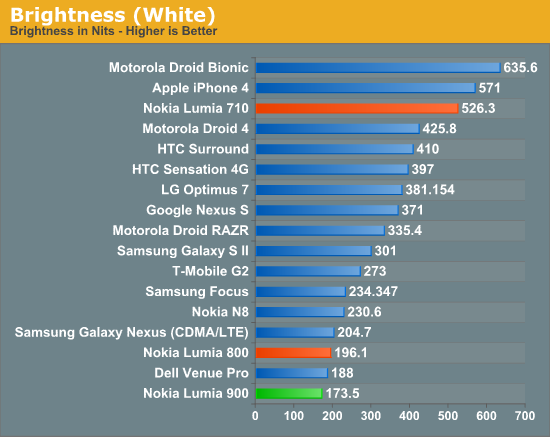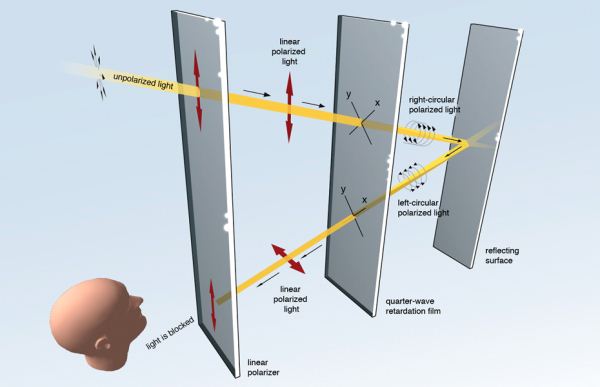Nokia Lumia 900 Review - Windows Phone with LTE
by Brian Klug on April 3, 2012 9:00 PM ESTDisplay Quality
Like the Lumia 800, the Lumia 900 uses an AMOLED display instead of an LCD. One of the chief differentiators between the two models however is the difference in subpixel rendering. Whereas the Lumia 800 used a 3.7“ PenTile RGBG SAMOLED panel, the Lumia 900 uses a 4.3” SAMOLED+ panel with an RGB subpixel stripe. Those names fit, that is, if we’re following Samsung’s naming scheme, and as an aside this is undoubtedly a Samsung panel.
The effective resolution of both displays are 800x480 WVGA, like all Windows Phones, however. Jumping up in display size pretty much necessitates that change to RGB, since PenTile really only works when subpixels are below human visual acuity. In addition, we’ve already seen 4.3" SAMOLED+ WVGA displays out of Samsung (see the Focus S).
I measured the Lumia 900 display using an i1D2 just like I’ve done with numerous other smartphones, though at this point the advanced color and gamut information will have to wait until I make some targets. Again, because AMOLED is emissive, black color pixels are literally off, so contrast graphs are omitted. The Lumia 900 doesn’t go super bright, like other AMOLEDs I’ve seen. In fact, it’s slightly dimmer than the Lumia 800’s maximum of 196 nits. Remember that going to a larger display, especially AMOLED due to its emissive nature, increases power demands as r^2 since we’re talking about areal size.
| Lumia 900 Display Metrics | |||
| Brightness Level | Black Brightness (nits) | White Brightness (nits) | White Point (K) |
| Low | 0 | 72.68 | 6635 |
| Medium | 0 | 140.06 | 6930 |
| High | 0 | 173.55 | 6812 |
Nokia was able to get the Lumia 900 display nice and close to 6500K, which is interesting considering how many other AMOLED displays I’ve seen which are up near 8000K or higher and noticeably blue all the time.

I glossed over ClearBlack on the previous Lumia reviews partly due to time constraints, partly due to not knowing the exact details of their optical path. That said, it was immediately obvious that the system used circular polarization’s behavior upon reflection to attenuate back reflections. However, since writing those reviews, Nokia has outlined their optical system in a conversations post, and the long and short of it is that the system consists of a linear polarizer and quarter-wave plate.
Incoming diffuse light gets vertically polarized by a surface polarizer, which becomes right hand circularly polarized when passing through the quarter wave plate. When circular polarized reflects off of a surface, it changes handedness - in this case from right to left handed circular. Upon passing through the quarter wave plate on its way out, this becomes horizontally polarized, which is then strongly attenuated by the surface polarizer with its fast axis aligned vertically on its way out, which acts like an analyzer. The end result is that outdoors the only reflection you’ll get is from the first surface, not the surface of the display itself, which does reduce resulting glare.
This change also permits the Lumia 900 to still look bright outside, and in turn allows Nokia to run the display at a lower brightness and save some amount of power. For a while I was waiting for some OEM to introduce a system using polarization to diminish back reflections, and Nokia has done it with ClearBlack.
Indoor viewing angles for the Lumia 900 are excellent as evidenced by the purple test pattern from WP Bench not changing color at extreme field angles. In addition, I subjectively can’t find any issues with the display - there are none of the other problems that affect the higher dot pitch AMOLEDs such as grain or mura. Outdoor viewing angles are likewise good for the Lumia 900 in part thanks to ClearBlack.

















128 Comments
View All Comments
name99 - Wednesday, April 4, 2012 - link
"However the labeling here is actually hilarious - AT&T’s WCDMA “4G” marketing carries over to the Lumia 900, so selecting “3G” from the drop down will score you a “4G” indicator in the status bar. Likewise selecting “4G” from the drop down gets you “LTE” in the status bar. Finally, a concrete example of where AT&T’s re-branding marketing has resulted in an actual namespace collision!"We have been through this a dozen times, Brian. You are just being immature if you keep pushing this point even after the relevant engineering issues have been explained to you many times.
If there is a name space collision here, it is because Nokia or MS are too stupid to understand that LTE is not the same thing as 4G, not because of an ATT fault.
ATT are major league dicks --- there's plenty about them to complain about honestly, without complaining about stupid non-issues.
Impulses - Thursday, April 5, 2012 - link
Seems like a valid complaint to me, at least from the point of view of the average consumer, regardless of whose fault it is. If AT&T can influence even Apple to change their connection indicators, surely they could force something less confusing here. It's not a coven to me, but the average consumer barely knows or cares what LTE & HSPA+ are, if they did the iPhone wouldn't be selling very well right now.leexgx - Friday, April 6, 2012 - link
MS naming (nice that they let you set the speeds 2g 3g and 4g speeds to bad you cant just force it to stay on one but that be asking to much)3g/H/H+ as 3g (WCDMA / UMTS / HSDPA / HSPA) and 4g as 4g (LTE or LTE-ADV) as it should be seems right to me (miss selling 4g when its not 4g is bad in the USA, hope Three in the UK do not start miss selling quite sure they Not be allowed to)
2g best signal and power bat life
3g lower bat life and calls and text may some times not work
4g more power drain less bat life (depends if its been used as LTE should have way better power use then 3g+ spec)
DarkUltra - Wednesday, April 4, 2012 - link
I think you should dig some more into WP7. I would not have bought a Lumia 800 if I knew about these:- Deleting gmail mail archives mail instead of deleting it
- Read, delete and move email operations is not pushed or synced immediately. Kinda disruptive and unnerving when you sit down in front of the computer and have to do it all over again
- international characters turn into æøå after a reply from a gmail account ruining the threading (could be issue with gmail but worked fine on my first gen iphone)
- no text wrap in ie9 so text on certain websites like anandtech and techreport is redicously small in portrait mode and uncomfortably small in landscape mode.
- no Find on Page
- no copy and paste in calendar
- no every other week timing in calendar
- no Other and custom phone numbers support in contacts
- If you set your locale to something like Norway, you get SV: and vs: instead of the regular Re: and Fwd: email subject abbrevations. After a bit back and fourth with people abroad the subject line ends up like this:
Re: SV: Re: SV: Re: SV: Smörgardsbord på Lørdag
- no native PDF support, must use a slow and unresponsive 3rd party reader that lack zoom to picture/paragraph and search
- Other and custom phone numbers in contacts
Many phone numbers from Outlook and Google doesn't show up
Othervise I really love this phone and its live tiles.
Klimax - Friday, April 6, 2012 - link
Corrections:"Deleting gmail mail archives mail instead of deleting it"
Setting in gmail.
"Read, delete and move email operations is not pushed or synced immediately. Kinda disruptive and unnerving when you sit down in front of the computer and have to do it all over again"
Again, setting in gmail.
Impulses - Thursday, April 5, 2012 - link
"I don't know that there's still a lot of iPhone/Windows Phone cross shopping, but a trend towards even cheaper on-contract prices for high-end smartphones is absolutely welcome."I agree with the latter statement... But as far as consumer choice, I think there might be more iPhone/WP cross shopping than iPhone/Android or even WP/Android. MS seems to be straddling this line between Apple's platform approach and Google's, and right now I think they're leaning slightly towards the former.
I think it's great for the market overall, and it's probably a winning strategy in the long run (something MS knows all about)... But right now I think Google's got more of the bargain/value market and the spec/geek market while Apple's carved itself a big chunk in between from average consumers looking to spend more but not necessarily focused on specs or sheer capability.
I'm definitely excited to see where WP & Nokia go next, despite being heavily invested in Android... Nokia needs MS more than MS needs Nokia tho, and WP isn't gonna budge from 3rd place if Nokia is the only OEM producing flagship type devices. Could be worse tho, they could be RIM!
PeteH - Thursday, April 5, 2012 - link
You make some good points, but I disagree that the MS approach is necessarily a winning strategy. If this was April 2010 when the smartphone market wasn't so mature I would completely agree that Windows stands an excellent chance of becoming (along with iOS/Android) a third dominant mobile platform. Unfortunately for MS it's April 2012, and it may be too late for Windows to be anything other than a niche player.I think the key question is can MS attract developers so that a strong stable of quality Apps can be built up rapidly. If they can it will greatly increase their chance of success.
Impulses - Thursday, April 5, 2012 - link
Meh, there's a lot of race still left to run imo, the smartphone market may be maturing rapidly but it's still in it's infancy... It's like in the stage the PC market was in the 80s imo.